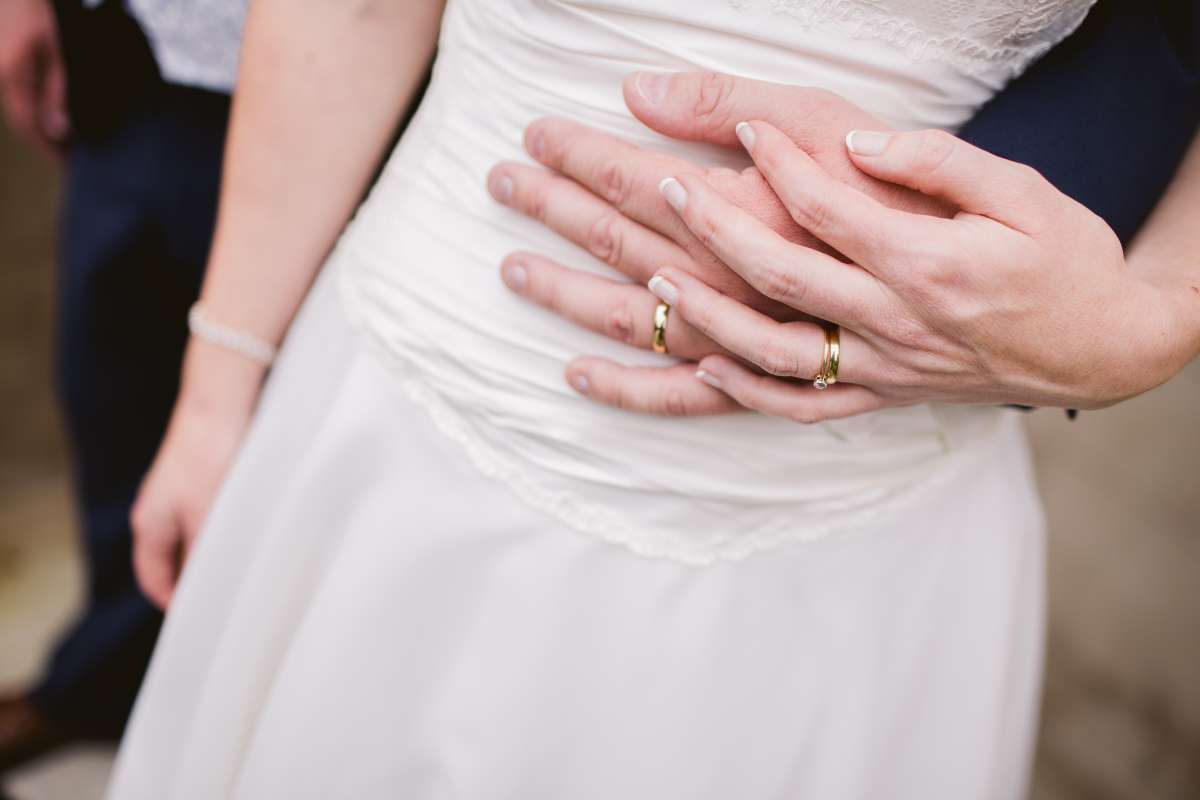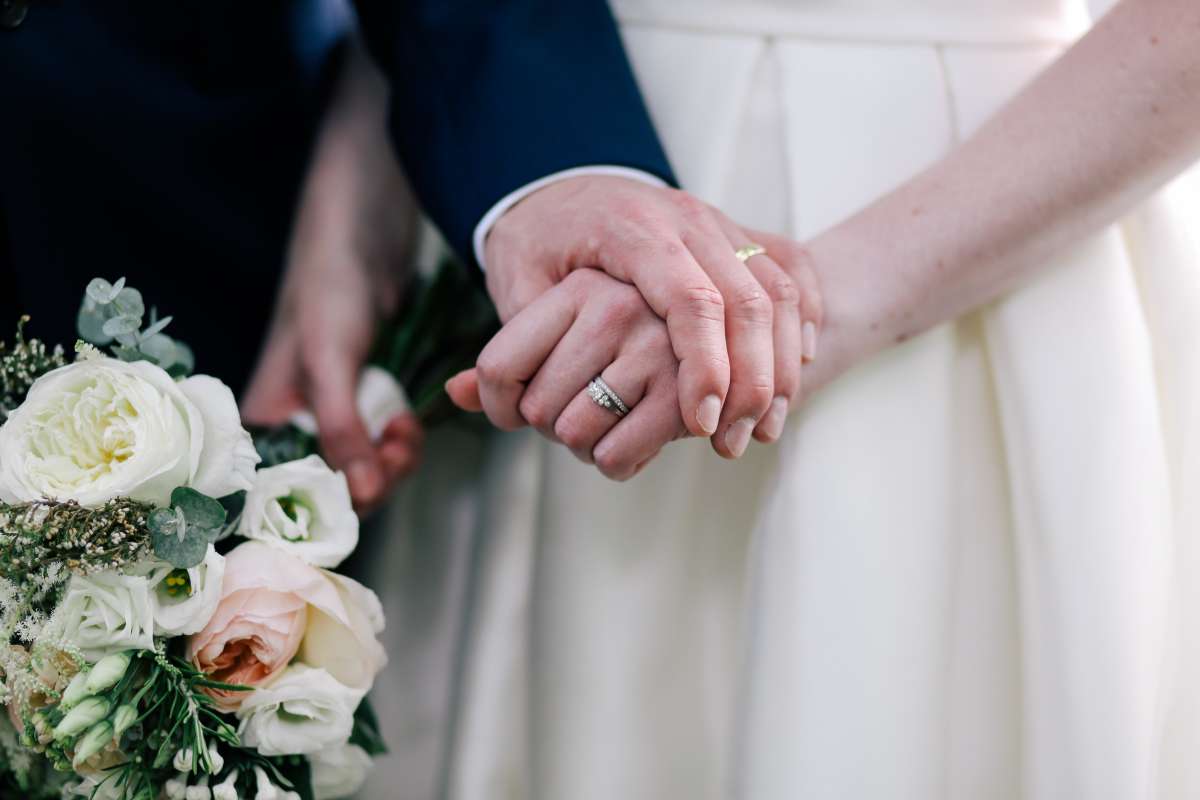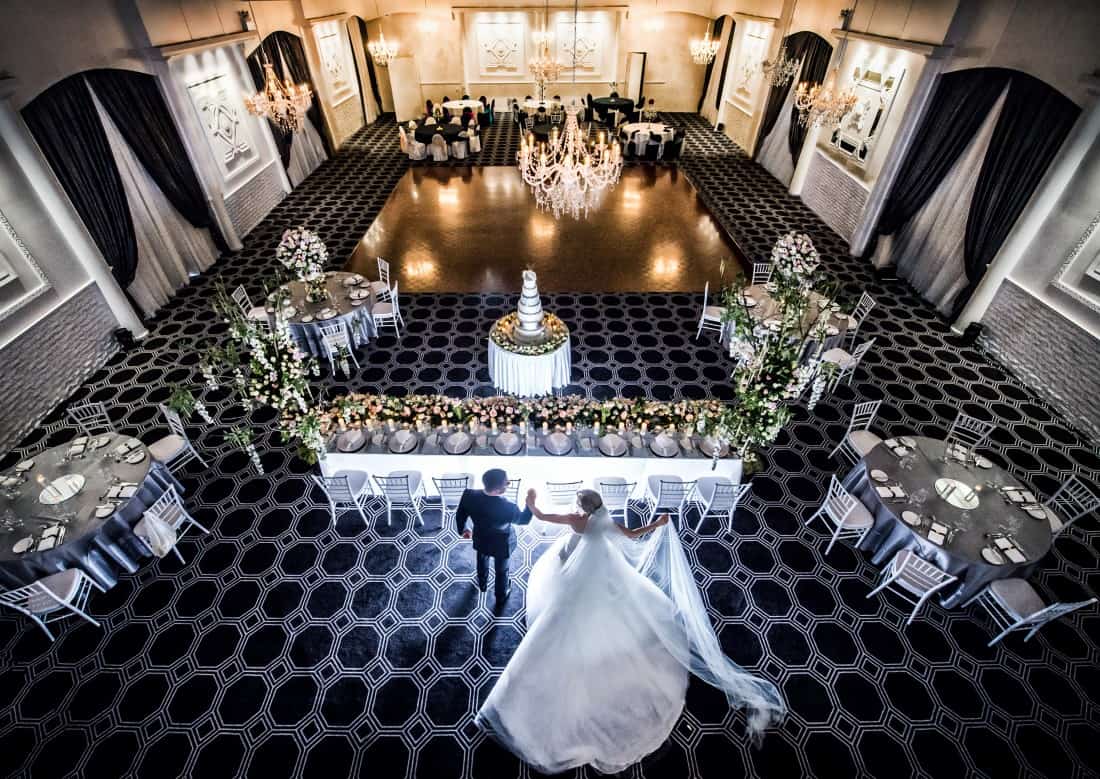Choosing the perfect wedding band is momentous, symbolising a lifelong commitment. But what if the ring size needs to be corrected? It’s not uncommon for wedding bands to need resizing, whether due to weight fluctuations, comfort issues, or simple mistakes in measuring. This article delves into the possibilities and limitations of resizing wedding bands, the materials that can and cannot be resized, and the different methods available to achieve the perfect fit.
Summary
Not all wedding bands can be resized; it depends on the material, design, and required size adjustment. Metals like gold, silver, platinum, and palladium are easier to resize, while tungsten, titanium, stainless steel, ceramic, and wood are difficult or impossible. Resizing methods include stretching, adding or removing metal, and soldering, each with different benefits and limitations. If resizing isn’t an option, alternatives like ring adjusters, chain attachments, or remodelling the ring can be considered.
Can All Wedding Bands Be Resized?
When it comes to resizing, not all wedding bands are created equal. Whether a wedding band can be resized largely depends on the ring’s material, design, and width. Understanding these factors is crucial before considering any resizing options. Here, we’ll break down which materials can and cannot be resized and why certain designs pose more of a challenge.
Materials That Can Be Resized
Certain materials are much easier to resize than others. Generally, softer and more malleable metals are ideal for resizing, while harder or more brittle materials may pose significant challenges. Here are some of the most commonly resized materials:
- Gold: Both yellow gold and white gold are among the most popular choices for wedding bands, and for a good reason—they are relatively easy to resize. Gold is a malleable metal that can be easily stretched or compressed. Yellow gold, being pure gold mixed with softer metals like copper or silver, offers flexibility in resizing without risking damage to the ring. White gold, typically alloyed with metals like nickel or palladium and coated with rhodium, is also easy to resize. However, restoring its original finish may require re-plating after the process.
- Silver: Silver is a soft metal like gold, making it ideal for resizing. Silver rings are often less expensive to resize than gold rings, primarily because of their lower material cost and ease of manipulation. However, silver is prone to scratching and tarnishing, so care must be taken during the resizing process to avoid damage.
- Platinum: Platinum is a durable and dense metal known for its strength and resistance to wear. Due to its hardness, it can be resized, but the process is more costly than resizing gold or silver. Platinum rings require a jeweller with specific skills and tools to handle the material without cracking or damaging it. While the cost is higher, platinum’s durability ensures the ring will remain in excellent condition for years, even after resizing.
- Palladium: Palladium rings, similar to platinum, can be resized, but the process is challenging and often expensive due to the strength and density of the metal. Like platinum, palladium is a member of the platinum group of metals, sharing similar properties such as high resistance to corrosion and a bright white finish. However, its hardness makes resizing more challenging, requiring specialised tools and expertise.
Materials That Cannot Be Resized
Some materials cannot be resized, or doing so would compromise their structural integrity or aesthetic appeal. These materials typically include metals that are too hard, too brittle or have a structure that does not allow alteration. Here are some materials that are commonly used in wedding bands but are not suitable for resizing:
- Tungsten: an extremely hard metal, often marketed as “scratch-proof” and “shatter-resistant.” While these properties make tungsten rings incredibly durable, they are also impossible to resize. The metal’s hardness means it cannot be cut, stretched, or compressed without breaking. For those who choose tungsten for its durability, ensuring the correct size from the start is crucial, as resizing is not an option.
- Titanium: Titanium is a lightweight, strong metal known for its hypoallergenic properties, making it a popular choice for wedding bands. However, titanium can only be resized without losing its structural integrity. Attempts to resize a titanium ring could result in cracks or damage, as the metal does not have the malleability required to be altered without significant risk.
- Stainless Steel: Stainless steel is durable and resistant to tarnishing but cannot be resized because it is too hard to manipulate. The tools required to cut and rejoin stainless steel rings are highly specialised and costly, making resizing impractical for most jewellers. Additionally, stainless steel does not have the flexibility to be resized without causing damage.
- Ceramic and Wood: Rings made from ceramic or wood are not candidates for resizing. Ceramic rings are highly resistant to scratches and discolouration, but their brittleness means they would crack or break under the pressure needed to resize them. Similarly, wood rings, while unique and stylish, lack the structural strength to withstand any form of resizing. These materials are fixed in shape and size, so their dimensions cannot be altered once the ring is crafted.
Methods Of Resizing A Wedding Band
If you’ve determined that your wedding band can be resized, a jeweller might use several methods. The appropriate method depends on the material, width, and design of the ring, as well as how much resizing is needed.
Stretching The Ring
One common method of resizing a ring is by stretching it. This method is suitable for rings made of softer metals like gold or silver and can typically only increase the ring size by half a size.
- Pros: Quick and relatively inexpensive.
- Cons: Limited to small size adjustments and unsuitable for rings with stones or intricate designs.
Adding Or Removing Metal
For larger adjustments, a jeweller may cut the ring and add or remove a piece of metal to achieve the desired size.
- Pros: Allows for significant size changes.
- Cons: More expensive and time-consuming than stretching. This method may leave a visible seam if not done carefully.
Soldering And Reinforcing
Suppose a ring has a complex design or stones set around the band. In that case, the jeweller may use a more advanced technique that involves cutting, resizing, and soldering the ring back together, then reinforcing the metal for durability.
- Pros: Suitable for more intricate designs.
- Cons: More expensive and requires a highly skilled jeweller.
Resizing With Inserts Or Ring Guards
Jewellers can use inserts or ring guards for rings that cannot be resized traditionally or for temporary solutions.
- Pros: Non-permanent solution that can adjust the size quickly.
- Cons: It may affect comfort and the overall appearance of the ring.
Alternatives To Resizing Your Wedding Band
If your wedding band cannot be resized, or you prefer not to alter it, there are a few alternatives to consider.
Ring Adjusters
These temporary, adjustable bands fit inside your ring to make it smaller. They’re a quick and easy solution but may only be comfortable for short-term wear.
Chain Attachments Or Ring Guards
For those looking for a semi-permanent solution, chain attachments or ring guards can be added to the inside of the ring to make it fit more snugly.
Repurposing Or Remodelling The Ring
If resizing is not an option, consider repurposing the metal and stones from the existing ring and putting them into a new design. This approach allows you to retain the sentimental value of the original ring while achieving the right size and style.
Conclusion
Resizing a wedding band is often possible but depends on various factors, including the ring’s material, design, and required size adjustment. Metals like gold, silver, platinum, and palladium are generally more accommodating to resizing. At the same time, materials such as tungsten, titanium, stainless steel, ceramic, and wood pose significant challenges or are impossible to resize. When resizing is feasible, methods like stretching, adding or removing metal, and soldering can be employed, each with pros and cons. For those whose rings cannot be resized, alternatives like ring adjusters, chain attachments, or even remodelling the ring can offer a practical solution. Consulting with a skilled jeweller will help you determine the best action to ensure your wedding band fits comfortably and retains its beauty.
FAQs About Wedding Bands
Which Material For Wedding Bands Is The Most Secure?
Platinum, a precious silvery-white metal, has recently become popular in the jewellery industry. For a long time, it has been considered the best metal for wedding and engagement rings.
What End Are Wedding Bands Worn?
Exchanging wedding rings (also called wedding bands) is a traditional part of the wedding ceremony. It symbolises the commitment of the couple getting married. Both rings have traditionally been worn as a set, with some examples even being welded together to form a single ring.
How About That Wedding Band Not Able To Be Severed?
The tungsten in your ring may not be able to be snipped out, but you can get it off without harming yourself if you need to. If you’ve done any reading or watching about tungsten rings, you know they’re practically indestructible.
Why Does The Wedding Band Go First?
Once married, the wedding band should be worn first, closer to the heart, followed by the engagement ring. They are both designed to be worn on the left hand’s third finger.
Do You Put The Band At The Top Or The Bottom?
First, you can customarily wear them by stacking them on the left-hand ring finger in the given order. Therefore, the diamond ring should be worn underneath the wedding band.



